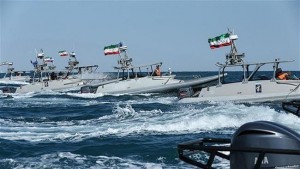On January 8, multiple Islamic Revolutionary Guard Corps (IRGC) Navy small attack craft harassed a group of U.S. naval vessels in the Persian Gulf, at one point coming within 900 yards of them. Iran’s nine-hour naval challenge ended when one of the U.S. ships fired three warning shots that caused the IRGC Navy craft to break off the encounter. According to the U.S. Navy, the American ships were on a routine mission in international waters, and the IRGC Navy actions constituted ‘unsafe’ and ‘unprofessional’ actions. No direct weapons fire occurred and there were no injuries.
The IRGC Navy challenge represented a renewed flare-up of recent U.S.-Iran tensions in the strategic Strait of Hormuz, through which one-third of all seaborne traded oil flows. In December, IRGC Navy vessels aimed at—but did not fire on—a U.S. military helicopter flying over the Gulf. In October, Iran-backed Houthi rebels in Yemen fired Iran-supplied anti-ship cruise missiles at U.S. and UAE naval vessels in the Red Sea. The missiles hit a UAE ship but missed the U.S. vessels, and prompted U.S. retaliatory attacks on Houthi-controlled radar installations. In August and September, the IRGC Navy conducted challenges similar—and with a similar U.S. response—to the events of January 8. Most analysts expect that similar Iranian provocations will continue, as Iran’s leaders seek to demonstrate to the incoming Trump administration that Iran is not intimidated by the President-elect’s characterization of Iran as a key adversary. That description represents a reversion to the U.S. view of Iran from the Iranian revolution in 1979 until the Obama administration; President Obama sought substantial engagement with Iran not only to curb Iran’s nuclear program but also in an effort to help resolve the conflicts roiling the region.
Aside from their uncertainty about the new administration’s policy on the multilateral Iran nuclear agreement, Iran’s leaders are particularly concerned about the President-elect’s nomination of Marine General James Mattis (ret.) as Secretary of Defense. As commander of U.S. Central Command from 2010 to 2013, General Mattis identified Iran as the most significant threat to U.S. interests in the region. Early in his tour, he advocated for U.S. military action against weapons factories inside Iran that were supplying Iraqi Shi’a militias attacking U.S. forces in Iraq. The Obama administration denied the request as too provocative in light of the administration’s attempts to engage Iran in negotiations on its nuclear program. President-elect Donald Trump has characterized the threat posed by Iran in terms similar to those articulated by General Mattis. As such, Mattis is likely to have presidential backing should he seek to allow U.S. forces in the Persian Gulf to respond to future IRGC Navy provocations with the use of deadly force.
In addition to potentially bringing U.S. and Iranian naval forces into direct conflict, continued Iranian naval provocations could influence the new administration’s decisions about the nuclear agreement. President-elect Trump has been sharply critical of the agreement on the grounds that it places unwarranted trust in Iran’s compliance, and provides Iran with additional resources to expand its influence in the region. However, since being elected, Trump has not stated that his administration will cease implementing the agreement or re-impose U.S. sanctions that have been lifted. Repeated Iranian naval harassment could empower those within the new administration who advocate abrogating the agreement or requesting that it be renegotiated. Alternately, the new administration might augment the U.S. force posture in the Persian Gulf and enhance the naval and air capabilities of America’s Gulf allies with additional sales of sophisticated arms. Further, additional Iranian provocations will likely result in the enactment of new U.S. sanctions on Iran’s development of ballistic missiles—which has substantial support even absent Iranian naval harassment.
Continued Iranian naval provocations will have deeper implications than simply coloring the views of the incoming Trump administration on Iran. Such Iranian actions—even if directed only at U.S. military assets—are likely to erode global support for the nuclear deal and for economic reengagement with Iran. Even though the nuclear agreement contains no specific restraints on Iran’s regional actions, the U.S and its negotiating partners entered into the deal with an expectation that Iran was seeking to reintegrate into the international community and end its ‘pariah’ status. Iranian naval provocations undermine that perception, as well as international confidence in Iran’s adherence to the accord. Should the U.S. impose any new sanctions on Iran as a consequence of its Gulf actions—even if such sanctions are not counter to the nuclear deal—European and Asian firms are likely to decline to reengage with Iran’s economy, and those firms that have reentered the Iranian market are likely to pull out. Therefore, the ultimate outcome of such provocative actions could lead Iran down a path back towards international isolation and economic distress.
soufangroup.com/



